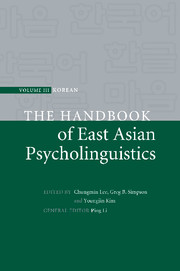Book contents
- Frontmatter
- Contents
- List of figures
- List of tables
- List of contributors
- Preface
- Introduction: Advances in Korean psycholinguistics
- Part I Language acquisition
- Part II Language processing
- 28 Visual processing of Hangul, the Korean script
- 29 English vowel spaces produced and perceived by Americans and Koreans
- 30 Morphological representation and processing of Sino-Korean words
- 31 The role of phonology in word recognition of Korean Hangul and Hanja
- 32 Lexical and sublexical processes in Korean word recognition
- 33 Prosody in sentence processing
- 34 Korean sentence processing
- 35 Sentence processing and memory representation in Korean
- 36 Understanding complex sentences: memory constraints and informational structure
- 37 ERP studies of Korean language processing: word-order effects
- 38 Inferences during discourse comprehension in Korean
- 39 Morpho-syntactic processing in Korean aphasics
- 40 Morpho-syntactic processing of Korean-speaking adults with Broca's aphasia
- 41 Comprehension deficits in Korean agrammatic aphasia
- 42 Developmental reading disorders in Korean
- 43 Individual differences in Korean language processing: context-dependent processing of skilled readers in word ambiguity resolution
- 44 A computational model of lexical and morphological processing in Korean
- References
- Name index
- Subject index
42 - Developmental reading disorders in Korean
from Part II - Language processing
Published online by Cambridge University Press: 05 June 2012
- Frontmatter
- Contents
- List of figures
- List of tables
- List of contributors
- Preface
- Introduction: Advances in Korean psycholinguistics
- Part I Language acquisition
- Part II Language processing
- 28 Visual processing of Hangul, the Korean script
- 29 English vowel spaces produced and perceived by Americans and Koreans
- 30 Morphological representation and processing of Sino-Korean words
- 31 The role of phonology in word recognition of Korean Hangul and Hanja
- 32 Lexical and sublexical processes in Korean word recognition
- 33 Prosody in sentence processing
- 34 Korean sentence processing
- 35 Sentence processing and memory representation in Korean
- 36 Understanding complex sentences: memory constraints and informational structure
- 37 ERP studies of Korean language processing: word-order effects
- 38 Inferences during discourse comprehension in Korean
- 39 Morpho-syntactic processing in Korean aphasics
- 40 Morpho-syntactic processing of Korean-speaking adults with Broca's aphasia
- 41 Comprehension deficits in Korean agrammatic aphasia
- 42 Developmental reading disorders in Korean
- 43 Individual differences in Korean language processing: context-dependent processing of skilled readers in word ambiguity resolution
- 44 A computational model of lexical and morphological processing in Korean
- References
- Name index
- Subject index
Summary
Abstract
In this article we consider some prominent features of the semi-syllabic Korean writing system (Hangul) and suggest how these might give rise to a distinct profile of reading disorder in dyslexic readers. We begin with a brief review of possible causes of developmental reading disorders and provide a short description of some significant features of the Hangul writing system in terms of why these may promote differences in the profile of Korean and English poor readers. We then review data from a recent study of good and poor developing Korean readers. The outcomes of this study are discussed in terms of the key findings that characterize Korean poor readers: the specific nature of their phonological awareness problems despite the lack of problems in processing dynamic visual stimuli. In explaining these results, we suggest that although the transparency of grapheme-to-phoneme mapping in Korean may assist in the development of intact phonological representations, problems may still occur in putting these representations to use. In accounting for why relatively few Hangul readers had visual processing problems, we propose that the straightforwardness of alphabetic depiction in Hangul and the constraint on letter ordering and placement, make it less likely that minor visual processing problems would lead to reading difficulties.
Introduction
Dyslexia, or specific reading disability, traditionally has been defined as the failure to acquire reading proficiency despite an average level of non-verbal intelligence, a supportive learning environment and no apparent physical, emotional or behavioral problems.
- Type
- Chapter
- Information
- The Handbook of East Asian Psycholinguistics , pp. 517 - 527Publisher: Cambridge University PressPrint publication year: 2009



